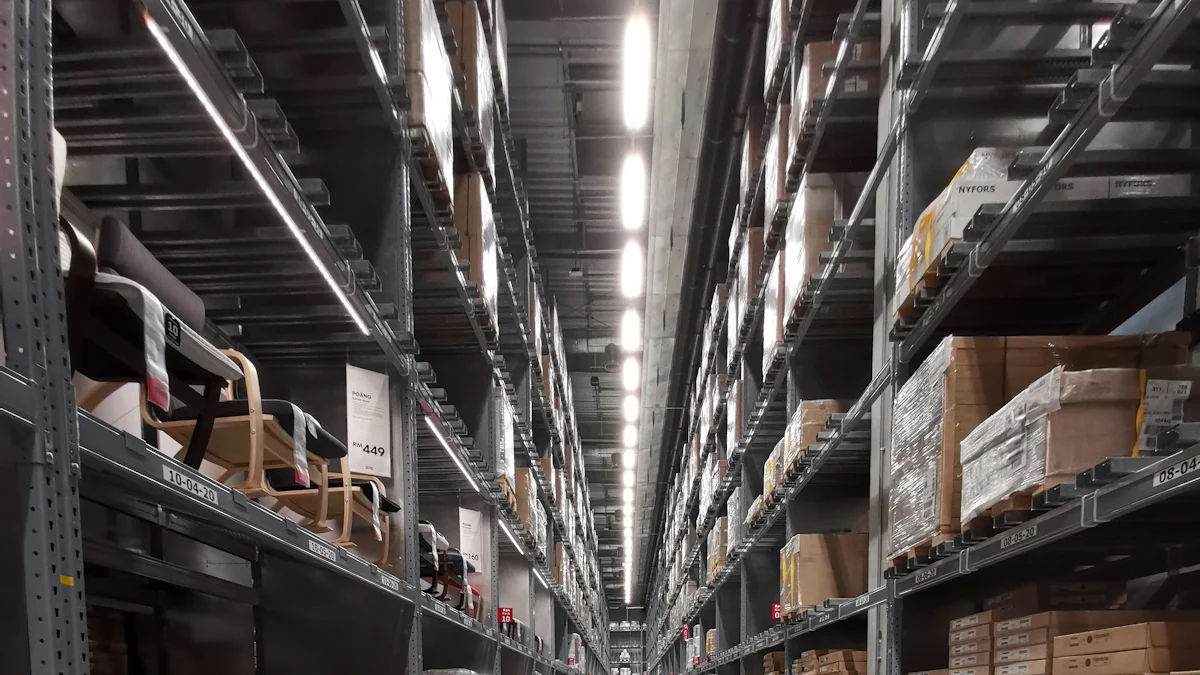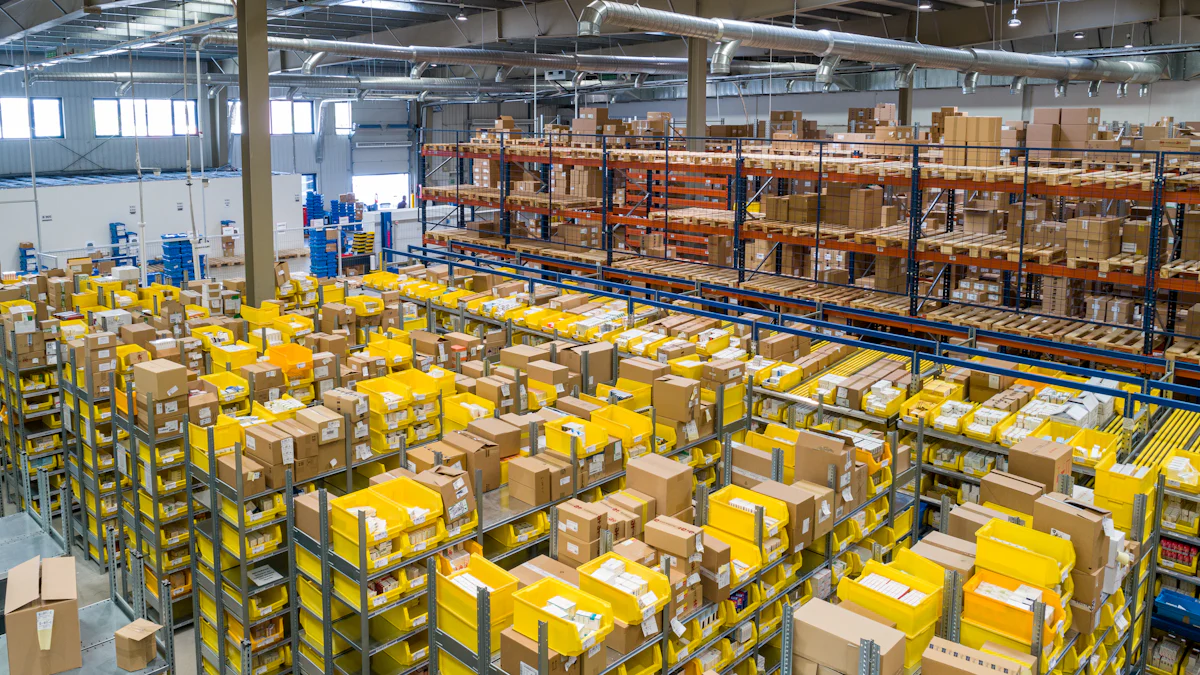Mastering Warehouse Operations: JUSDA's Strategic Approach to Supply Chain Efficiency

JUSDA stands as a significant player in the logistics industry. The company manages over 2.5 million square meters of warehousing space across 155+ service locations worldwide. Effective warehouse management is crucial for modern supply chains. It ensures precise stock control and minimizes excess inventory. JUSDA leverages cutting-edge technologies to enhance inventory tracking accuracy and streamline order processing. This blog aims to provide a comprehensive guide on JUSDA’s warehouse management strategies and practices.
Understanding Warehouse Management
Definition and Importance
What is Warehouse Management?
Warehouse management involves overseeing the daily operations within a warehouse. This includes receiving, storing, and shipping goods. Effective warehouse management ensures that inventory moves smoothly through the supply chain. Proper management helps maintain order and efficiency.
Why is it Crucial for Supply Chain Efficiency?
Efficient warehouse management plays a vital role in supply chain operations. It ensures that products are available when needed. This reduces delays and keeps customers satisfied. Warehouse management is a critical aspect of supply chain operations, ensuring the seamless flow of goods from receipt to delivery. Proper management minimizes costs and maximizes operational efficiency.
Key Components of Warehouse Management
Inventory Management
Inventory management involves tracking and controlling stock levels. This ensures that the right amount of inventory is available at all times. Accurate inventory management prevents overstocking and stockouts. This component helps maintain a balance between supply and demand.
Order Fulfillment
Order fulfillment covers the process of picking, packing, and shipping orders. Efficient order fulfillment ensures that customers receive their products on time. This component directly impacts customer satisfaction. Streamlined order fulfillment processes reduce errors and improve delivery times.
Storage and Layout Optimization
Storage and layout optimization involves organizing the warehouse space effectively. This ensures that items are stored in a way that maximizes space and accessibility. Proper layout optimization reduces the time spent locating items. This component enhances overall warehouse efficiency.
JUSDA’s Approach to Warehouse Management
Overview of JUSDA’s Strategies
JUSDA employs several strategies to optimize warehouse management. The company focuses on precision and efficiency. JUSDA leverages advanced technologies to enhance its operations. These strategies ensure that the warehouse functions smoothly and effectively.
Technological Integration
Technological integration plays a crucial role in JUSDA’s warehouse management. The company uses state-of-the-art systems to track inventory and manage orders. These technologies improve accuracy and reduce manual errors. Automated systems streamline various processes within the warehouse.
Workforce Management
Workforce management is another key aspect of JUSDA’s approach. The company invests in training and development programs for its employees. Skilled workers contribute to the overall efficiency of the warehouse. Proper workforce management ensures that the staff is well-equipped to handle daily operations.
Efficient warehouse optimization is essential for businesses to maximize operational efficiency and minimize costs. JUSDA’s comprehensive approach to warehouse management reflects this principle. By focusing on key components and integrating advanced technologies, JUSDA ensures optimal performance in its warehouses.
JUSDA’s Warehouse Management Processes

Receiving and Inspection
Steps in the Receiving Process
JUSDA begins with a meticulous receiving process. The warehouse staff first verifies incoming shipments against purchase orders. This step ensures that all received items match the order specifications. Next, the team unloads the goods and checks for any visible damages. Proper documentation follows, recording the details of the received inventory. Finally, the staff moves the items to designated storage areas.
Quality Control Measures
Quality control remains a top priority at JUSDA. The team conducts thorough inspections to ensure product quality. This includes checking for defects, verifying quantities, and confirming product specifications. Advanced technologies like AI-driven solutions assist in identifying discrepancies. These measures guarantee that only high-quality products enter the warehouse inventory.
Storage and Inventory Control
Storage Techniques
JUSDA employs various storage techniques to maximize space utilization. The warehouse uses vertical storage systems to make the most of available space. Items are categorized and stored based on their size, weight, and frequency of use. This method ensures easy access and efficient retrieval. Pallet racking systems and automated storage solutions further enhance storage efficiency.
Inventory Tracking Systems
JUSDA leverages cutting-edge Warehouse Management Systems (WMS) for inventory tracking. These systems provide real-time visibility into stock levels. Businesses can monitor inventory movements accurately, minimizing excess stock and preventing stockouts. The integration of smart drones enhances inventory tracking accuracy. This meticulous control over inventory levels boosts operational efficiency.
Order Processing and Fulfillment
Order Picking Methods
Order picking is a critical component of JUSDA's warehouse management. The company employs various picking methods to streamline this process. Batch picking allows the staff to pick multiple orders simultaneously, reducing travel time. Zone picking assigns specific areas to workers, ensuring faster order fulfillment. Advanced technologies like robotics and automation further optimize order picking.
Packaging and Shipping Procedures
Packaging and shipping follow a structured process at JUSDA. The staff ensures that products are securely packed to prevent damage during transit. Automated packaging systems enhance speed and accuracy. Once packed, the items move to the shipping area. Here, the team verifies the shipping details and prepares the orders for dispatch. Real-time tracking systems provide updates on the shipment status, ensuring timely delivery.
Benefits of JUSDA’s Warehouse Management System
Increased Efficiency
Time-saving Processes
JUSDA’s warehouse management system employs advanced technologies to streamline operations. Automated systems handle repetitive tasks, reducing the time required for manual processes. For instance, automated storage and retrieval systems (AS/RS) quickly locate and move items, saving valuable time. This efficiency allows workers to focus on more complex tasks, enhancing overall productivity.
Reduced Errors
Implementing a robust warehouse management system minimizes human errors. Advanced tracking systems ensure accurate inventory counts, preventing discrepancies. Real-time data updates provide precise information about stock levels. This accuracy reduces the likelihood of picking and shipping errors, leading to smoother operations and higher customer satisfaction.
Cost Reduction
Optimized Resource Utilization
JUSDA’s approach to warehouse management focuses on maximizing resource utilization. Efficient layout designs and storage techniques make the best use of available space. Vertical storage solutions and smart shelving systems increase storage capacity without expanding the warehouse footprint. This optimization reduces the need for additional storage facilities, lowering operational costs.
Lower Operational Costs
By integrating technology into warehouse management, JUSDA significantly cuts down on operational expenses. Automated systems reduce labor costs by handling tasks that would otherwise require multiple workers. Energy-efficient lighting and climate control systems lower utility bills. These cost-saving measures contribute to a more sustainable and profitable operation.
Enhanced Customer Satisfaction
Faster Delivery Times
Efficient warehouse management directly impacts delivery times. JUSDA’s streamlined order fulfillment processes ensure that products are picked, packed, and shipped quickly. Advanced tracking systems provide real-time updates on order status. Customers receive their orders faster, which boosts satisfaction and loyalty.
Improved Order Accuracy
Accurate order processing is crucial for maintaining customer trust. JUSDA’s warehouse management system employs barcode scanning and RFID technology to ensure precise order picking. This technology verifies each item before it leaves the warehouse, reducing the chances of incorrect shipments. High order accuracy leads to fewer returns and happier customers.
Challenges in Warehouse Management
Common Issues
Space Constraints
Space constraints often challenge warehouse management. Limited space can lead to cluttered aisles and inefficient storage. This disorganization slows down operations and increases the risk of accidents. Businesses struggle to find enough room for new inventory, which disrupts the supply chain.
Inventory Inaccuracies
Inventory inaccuracies pose another significant issue. Miscounts and misplaced items lead to stock discrepancies. These errors cause delays in order fulfillment and result in customer dissatisfaction. Manual tracking methods often contribute to these inaccuracies, making it hard to maintain precise inventory levels.
JUSDA’s Solutions
Space Optimization Techniques
JUSDA employs innovative space optimization techniques to tackle space constraints. The company uses vertical storage systems to maximize space utilization. Items are categorized based on size and frequency of use. This method ensures easy access and efficient retrieval. Automated storage solutions further enhance space efficiency by reducing the need for manual handling.
Advanced Inventory Management Systems
JUSDA leverages advanced inventory management systems to address inventory inaccuracies. The company uses real-time tracking systems to monitor stock levels. These systems provide accurate data, reducing the likelihood of errors. Smart drones and RFID technology enhance inventory visibility and accuracy. This meticulous control over inventory ensures smooth operations and high customer satisfaction.
Best Practices for Effective Warehouse Management

Regular Audits and Inspections
Importance of Routine Checks
Routine checks play a vital role in maintaining warehouse efficiency. Regular audits help identify discrepancies in inventory levels. These checks ensure that all processes run smoothly. Audits also uncover potential issues before they escalate.
Routine inspections contribute to a safer work environment. Identifying hazards early prevents accidents. Regular checks maintain the quality of stored goods. This practice keeps the warehouse organized and efficient.
How to Conduct Effective Audits
Conducting effective audits requires a structured approach. Start with a clear plan outlining the audit's scope. Use a checklist to ensure all areas receive attention. Include inventory counts, equipment checks, and safety inspections.
Involve trained staff in the audit process. Their expertise ensures accurate assessments. Use technology like barcode scanners for precise inventory tracking. Document findings thoroughly and address any issues promptly.
Employee Training and Development
Training Programs
Investing in employee training boosts warehouse performance. Training programs equip staff with essential skills. Cover topics like inventory management, safety protocols, and equipment operation. Regular training keeps employees updated on best practices.
Hands-on training sessions enhance learning. Practical exercises help employees apply new skills. Use experienced staff to mentor new hires. This approach fosters a knowledgeable and capable workforce.
Continuous Improvement Initiatives
Continuous improvement initiatives drive long-term success. Encourage employees to suggest process improvements. Implement a feedback system to gather their insights. Regularly review and refine warehouse procedures.
Promote a culture of ongoing learning. Offer advanced training opportunities for experienced staff. Recognize and reward employees who contribute to improvements. This practice motivates the team and enhances overall efficiency.
Leveraging Technology
Use of Warehouse Management Systems (WMS)
Warehouse Management Systems (WMS) revolutionize operations. These systems provide real-time visibility into inventory levels. WMS streamlines order processing and reduces manual errors. Automated alerts notify staff of low stock or discrepancies.
Implementing a WMS improves accuracy and efficiency. The system tracks inventory movements precisely. This technology minimizes excess stock and prevents stockouts. Businesses benefit from smoother operations and better resource utilization.
Automation and Robotics
Automation and robotics transform warehouse management. Automated systems handle repetitive tasks efficiently. Technologies like Automated Storage and Retrieval Systems (AS/RS) speed up item retrieval. This reduces the time workers spend on manual tasks.
Robotics enhance order picking accuracy. Robots navigate the warehouse and pick items quickly. This technology reduces picking errors and increases productivity. Integrating automation leads to faster order fulfillment and higher customer
Effective warehouse management remains crucial for supply chain success. JUSDA’s strategies enhance efficiency, reduce costs, and improve customer satisfaction. The future of warehouse management looks promising with advancements in technology and best practices. Readers should consider implementing these strategies to optimize their own operations.
See Also
Enhanced Efficiency with JUSDA's Logistics Technology
Revealing JUSDA's Enhanced Efficiency in New Warehousing Facilities
Expertise in Inventory Optimization by JUSDA
Redefining Efficiency through JUSDA's Logistics Optimization
Exploring JUSDA's Smart Logistic Systems Implementation Case Study
